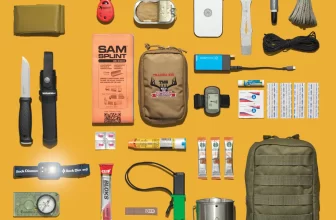Are you planning for an exciting hiking or camping adventure? One important factor to consider is the type of clothing you pack. After all, you don’t want to be uncomfortable or ill-prepared for unexpected weather changes. In this article, we’ll discuss the best types of clothing for hiking and camping in various weather conditions, so you can enjoy your outdoor experience to the fullest.
When it comes to clothing for hiking and camping, layering is key. Whether you’re expecting cold, hot, or unpredictable weather, dressing in layers allows you to adjust your clothing as needed. Start with a moisture-wicking base layer to keep you dry and regulate your body temperature. Over this, add an insulating layer made of materials like fleece or wool to provide warmth. Finally, top it off with a waterproof and breathable outer layer to protect you from rain or snow.
In colder weather, it’s crucial to keep your extremities warm. Investing in high-quality wool socks, insulated gloves, and a beanie will help to retain heat and prevent frostbite. Don’t forget to pack a reliable pair of waterproof and comfortable hiking boots to keep your feet dry and supported throughout your hike. However, in warmer weather, opt for lightweight, breathable fabrics like linen or cotton to help you stay cool and comfortable.
In conclusion, the type of clothing you choose for hiking and camping depends on the weather conditions you expect to encounter. Layering your clothing and packing the appropriate accessories, such as gloves and hats, will help keep you comfortable and protected. Stay tuned for our upcoming article, where we’ll delve into specific clothing recommendations for different weather conditions, so you can be fully prepared for your outdoor adventure.
Clothing for Hiking and Camping
When venturing into the great outdoors for hiking and camping, choosing the right clothing is essential. The clothes you wear can greatly affect your comfort and safety, especially when facing different weather conditions. Whether you’re heading out in cold, hot, rainy, snowy, windy, humid, or variable weather, it’s crucial to be prepared with suitable clothing. In this article, we will explore the importance of proper clothing and provide considerations and recommendations for each weather condition.
Importance of Proper Clothing
Wearing the proper clothing when hiking and camping is vital for several reasons. First and foremost, it helps regulate your body temperature, allowing you to stay warm or cool as needed. Additionally, appropriate clothing can protect you from the elements, such as rain, wind, snow, and sun. It can also provide insulation and prevent chafing and blisters, reducing the risk of discomfort and injury. Lastly, wearing the right gear ensures that you can move freely and comfortably, enhancing your overall hiking and camping experience.
Considerations for Different Weather Conditions
Before we delve into specific clothing recommendations for various weather conditions, it’s important to consider a few general factors. First, consider the duration and intensity of your outdoor activities. Longer hikes or overnight camping may require more versatile clothing options. Second, assess the terrain and altitude you’ll be encountering. Different terrains and altitudes can significantly impact the temperature and weather conditions you’ll face. Lastly, always check the weather forecast before heading out and prepare accordingly.
Clothing for Cold Weather
When braving cold weather during your hiking and camping adventures, layering is key. Start with a moisture-wicking base layer that will keep sweat away from your body. This layer should be followed by an insulating mid-layer, such as a fleece or down jacket, to trap heat. Finally, don a waterproof and windproof outer layer to protect yourself from snow, rain, and wind. Don’t forget to wear thermal underwear and warm socks to keep your extremities cozy. Additionally, investing in a good pair of insulated hiking boots and wearing a hat, gloves, and a scarf will help retain heat.
Clothing for Hot Weather
Hiking and camping in hot weather requires clothing that is breathable, lightweight, and protects you from the sun. Opt for moisture-wicking and quick-drying materials, such as nylon or polyester, that will keep you cool and dry. Choose loose-fitting shirts and pants to promote ventilation and airflow. Long-sleeved shirts are also ideal for protecting your arms from the sun’s harmful rays. Don’t forget to wear a hat with a wide brim and sunglasses to shield your face and eyes from the intense sun. Lastly, ensure you have comfortable and breathable footwear, such as hiking sandals or lightweight hiking shoes.
Clothing for Rainy Weather
When facing rainy weather during your outdoor escapades, staying dry is paramount. Invest in a high-quality waterproof rain jacket and pants made from breathable materials. Look for gear with sealed seams to prevent water from seeping in. It’s also essential to wear a moisture-wicking base layer to keep sweat away from your body. Choose rain gear with adjustable hoods and cuffs to provide added protection against the elements. Additionally, consider wearing waterproof hiking boots and gaiters to keep your feet dry and protected from mud and puddles.
Clothing for Windy Weather
Hiking and camping in windy conditions requires clothing that can withstand the gusts while keeping you warm and comfortable. Opt for windproof outer layers that offer insulation as well. A softshell jacket or a windbreaker is an excellent choice to keep the wind from penetrating your layers. Wear a hat that fits snugly on your head, such as a beanie or a baseball cap with ear flaps. Additionally, consider wearing a neck gaiter or a scarf to protect your neck and face from cold winds. Don’t forget to wear gloves that offer wind protection without compromising dexterity.
Clothing for Snowy Weather
When venturing out in snowy conditions, it’s crucial to have specialized clothing that will keep you warm, dry, and protected. Start with a moisture-wicking base layer, followed by an insulating mid-layer, such as a fleece or down jacket. Your outer layer should be a waterproof and breathable snow jacket and pants. Ensure that your pants are reinforced in areas prone to abrasion, such as the knees and seat. Insulated and waterproof boots are a necessity to keep your feet warm and dry. Lastly, wear a beanie, gloves, and a neck gaiter or balaclava to protect exposed skin from frostbite.
Clothing for Humid Weather
Hiking and camping in humid weather can be challenging due to excessive sweating and discomfort. Choose lightweight and breathable materials that wick moisture away from your skin, such as merino wool or synthetic fabrics. Opt for moisture-wicking shirts and pants to keep you cool and dry. Consider wearing loose-fitting clothing to promote airflow. A wide-brimmed hat and sunglasses will provide much-needed sun protection. Lastly, prioritize footwear that offers excellent breathability and moisture-wicking properties, such as trail running shoes or ventilated hiking boots.
Clothing for Variable Weather
When hiking and camping in areas with unpredictable or rapidly changing weather, being prepared for all conditions is essential. Layering is crucial in this situation. Start with a moisture-wicking base layer, followed by insulating mid-layers that can be easily added or removed as the temperature fluctuates. Carry a lightweight, packable rain jacket and pants to protect against rain showers. Additionally, always pack a hat, gloves, and a warm outer layer to ensure your preparedness for sudden drops in temperature. Keep in mind that being adaptable and having versatile clothing options is key when facing variable weather conditions.
Conclusion
Whether you’re facing cold, hot, rainy, snowy, windy, humid, or variable weather during your hiking and camping adventures, having the right clothing is paramount. Consider the duration and intensity of your activities, the terrain and altitude you’ll encounter, and always check the weather forecast before heading out. Layer appropriately, choose moisture-wicking and quick-drying materials, and invest in waterproof and windproof gear when necessary. By being properly equipped, you can ensure your comfort, safety, and enjoyment while exploring the wonders of the great outdoors.








